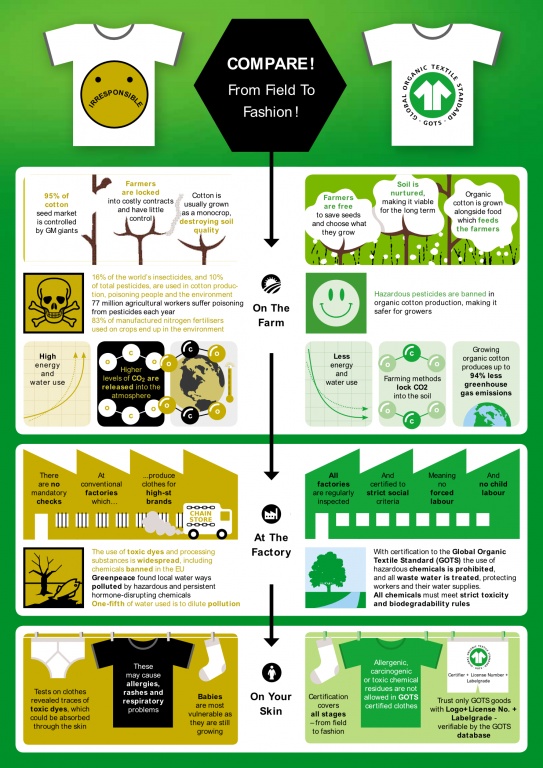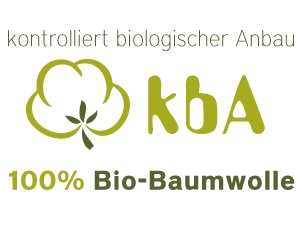Information about certificates

WHAT IS GOTS? The Global Organic Textile Standard (GOTS) is the first international standard to require strict biological AND social standards throughout the textile production chain. This means that at least 70% of the fibers from GOTS-certified textiles must come from certified and controlled organic farms or certified organic livestock. Strict biological and social standards must be observed in the further processing of raw materials. Read more on the official GOTS website www.global-standart.org
This video on GOTS briefly and concisely explains that it is not enough to use organic cotton fibers in the production of the product but to take into account the whole production chain, from organic cotton grown in the field, harvesting in an environmentally and human-friendly way, from delivery to recycling points as efficiently as possible and finally with the sale of finished products following the strict rules of GOTS, so that the end result is a product that is as clean as possible, free of chemicals and harmful dyes.
For mored information, watch a short :documental movie about GOTS!
The picture briefly and compares the production of conventional cotton T-shirt with the production of GOTS certified organic cotton T-shirt!

We offer and will continue to supplement the range of our store with the highest quality GOTS certified organic cotton fabrics, which contain at least 94% organic fibers.

OEKO-TEX ® standart 100 (SWITZERLAND)
There is a worldwide adapted, independent testing and certification system, established in 1992 as an international association for textile ecological research and testing to perform testing and certification for:
- unprocessed textile products;
- semi-finished textile products;
- finished textile products,
at all stages and levels of their processing, as well as by checking all the materials used in them. Examples of products that can be certified: raw and dyed/finished yarns, woven and knitted fabrics, accessories such as buttons, zippers, sewing threads or labels, various types of finished products (all types of clothing, household textiles, bed linen, terry products and much more).Oeko-Tex Standart 100 is controlled by a third party:
- evaluate harmful substances
- publicly available testing standards
- tests:
- unauthorized substances, such as carcinogens
dyes;
- substances restricted by legislation,
such as formaldehyde;
substances which are considered as
harmful, but the legislation still
does not restrict, for example, pesticides,
allergic dyes;
- color fastness and skin-friendly pH
level;
- for the whole product - from thread to
patterns - must comply with the standards specified in Oeko-Tex Standard 100;
- defined 4 product classes (the closer to the skin, the
more strict requirements):
- products for children under the age of 3
Oeko-Tex Standart 100 Class 1
- products close to the skin, such as
underwear Oeko-Tex Standart 100 Class 2
- goods from leather,
such as coats Oeko-Tex Standart 100 Class 3
- - home textiles,
curtains, tablecloths Oeko-Tex Standart 100 Class 4
For more information, visit the official website www.oeko-tex.com
Oeko-Tex Standart 100 Class 1 certificate guarantees the use of non-polluting and environmentally friendly dyes in the fabrics we offer.

The kbA Baumwolle label confirms that the use of chemical fertilizers, defoliants, and synthetic pesticides in the production of the product is prohibited. Therefore, raw cotton has a very low allergy potential and is gentle on the skin. Organic farming is monitored and certified annually by independent institutes such as the Swiss Institute of Market Ecology (IMO). For cotton, there are also additional certification criteria, such as fair pricing and compliance with social standards.
In regards to organic cotton, the soil must be managed for three years without chemicals. In addition, cultivation takes place in a mixed crop rotation. The cotton is harvested by hand only. The soil receives the necessary nutrients from natural fertilizers, such as manure and mulch. Which has a positive effect on carbon dioxide emissions. The significant bugs are also controlled by ecological means, such as Duftlockstoffen, and weeds are removed mechanically. The social aspect is also an important factor in growing organic cotton. Without the use of chemicals, people working in the fields are not exposed to harmful substances.
What is an ISO 14000 certificate?
ISO 14000
What is ISO 14000?
ISO 14000 - a series of internationally recognized standards for the establishment of environmental management systems in organizations and companies, the purpose of which is to support environmental protection and prevent environmental pollution, balancing this activity with socio-economic needs. ISO 14000 is one of the world's most recognized standards for environmental management systems. The number of organizations certified to this standard worldwide currently exceeds 21,000. Registration to ISO 14000 standards is increasingly required by businesses, especially European consumers.
The need for ISO 14000
None of the organizations exist in an environmental vacuum. The activities of each organization are influenced by several stakeholders - legislators, insurance agencies, consumers, suppliers, company employees, and society as a whole, each of which has its specific wishes and interests. Also, society's growing environmental awareness is affecting business on a global scale, as entrepreneurs must strive to comply with both government laws and consumer expectations. International standards help to safeguard the interests of stakeholders.
What does ISO 14001 contain?
ISO 14001 is the main document in the ISO 14000 series of standards. This document is used for certification. It details how the environmental management system should be defined and implemented. ISO 14001 requires the implementation of an environmental management system. ISO 14001 can apply to all types of organizations, large and small, in any industry, ISO 14000 can apply to the whole or part of an organization. An important aspect of the standard is that it focuses on continuous improvement, resulting in many companies increasing profits.
Environmental development guidelines
International and local standards, as well as legislation, incorporate and improve viable and revised development requirements for the environment, meeting the needs of the current generation so that future generations can meet their own needs and aspirations.
Revised guidelines for viable development are:
•The availability level of resources with natural regenerative capacity is lower than up to the regeneration level.
•Resources that do not have a natural capacity for regeneration must be used as rationally as possible.
•Development technologies need to take into account the potential of these technologies to fill gaps in the use of resources that do not have natural regenerative capacity.
•As an alternative, those resources that have a natural capacity for regeneration should be used instead of those that cannot regenerate naturally.
The essence of maintaining sustainable development
Loss of resources <Resource recovery
A certified environmental management system can give a company a competitive advantage over those customers who are strongly committed to protecting the environment. This certified system confirms that the company cares about environmental issues and the future of all mankind.
Source - https://zygon.lv/daliba-projektos/projekts-2/

 info@debesuplavas.com
info@debesuplavas.com

